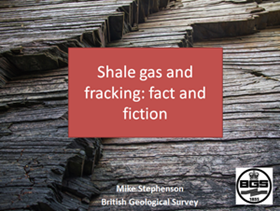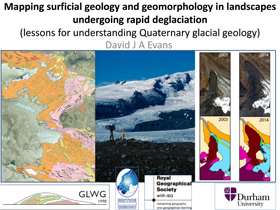Resources from past events organised by the Central Scotland Regional Group can be found below. If there is an event you would like details for, or questions about any past meeting resources please email CSRG.
Deep Geothermal Energy in the UK
Date: 3rd March 2022
Speaker: Darren Jones, BGS
Followed by: 2022 Annual General Meeting
Meteorites: A Brief History
Date: 27th October 2021
Speaker: Peter Davidson, National Museum of Scotland
Space Weather & Its Impact on Ground Based Technological Infrastructure
Date: September 2021
Speaker: Dr Gemma Richardson, BGS
Glasgow Quay Walls Ground Investigation: a Practical Example
Date: 27th April 2021
Speaker: Sean Gallacher, Atkins
Monitoring Coastal Erosion from Space: What is Feasible & How Confidant are we on the Changes Detected
Date: 25th February 2021
Speaker: Dr. Andres Payo, British Geological Survey
Website: https://coastalerosion.argans.co.uk/
Tracking Dinosaurs in Scotland
Date: 10th November 2020
Speaker: Dr. Neil Clark, Curator of Palaeontology, Hunterian Museum, Glasgow
3D Design & Visualisation Tools for Geological Models & Geotechnical Engineering
Date: 29th September 2020
Speaker: Richard Passe, COWI UK
At the Crossroads of Engineering Geology & Rock Engineering - Large Rock Cutting Design in Gothenburg
Date: 27 August 2020
Speakers: Michael Setter, Juan Sesma Plaza & Chris Jack, COWI
CGeol & CSci Chartership Process Talk
Date: 23 July 2020
Speaker: Shaun Richardson, Chartership Officer, The Geological Society
- Lecture video (some introductory slides missing due to recording issue)
Getting in to Hot Water: Geothermal Energy Resources Explained with a Case Study Focused on the Cheshire Basin
Date: 27 February 2020
Speaker: Dr Catherine Hirst, COWI UK
The Lines of Evidence Approach to Challenges Faced in Engineering Geology Practice (Based on the 19th Glossop Lecture)
Date: 23 October 2019
Speaker: Kevin Privett, Visiting Research Fellow, School of Earth & Environmental Sciences, University of Portsmouth
- Lecture video (as recorded by the Engineering Group of the Geological Society)
Scotland's Buried Valleys, a BGS Presentation on Buried Valleys in Superficial Geology in Scotland
Date: 11 September 2019
Speaker: Dr Tim Kearsey, Sedimentary Geologist & Project Leader, British Geological Survey
Landslide Hazard & Risk Assessment
Date: 13 June 2019
Speaker: Steve Parry, Parry Engineering Geoservices
Sub-surface Laser Scanning, Multi-beam Sonar Surveys & Void Surveys
Date: 12 February 2019
Speaker: Mark Hudson, Managing Director, Geoterra
LiDAR: Surveyors Toy or Geologists Tool?
Date: 18 October 2018
Speaker: James Moncrieff, General Manager, Maptek
Management of Permo-Triassic Sandstone Aquifers
Date: 6 September 2018
Speaker: Keith Seymour, GSL Vice President for Regional Groups
Dreaming of Sustainable Urban Ecosystems: resilience of garden, park and forest soils in contaminated landscapes
Date: 23 January 2018
Speaker: Professor Andrew S Hursthouse
Standards and Quality in Ground Investigations - 2016 Glossop Lecture
Date: 14 November 2017
Speaker: Professor David Norbury
The Glossop Lecture is the most prestigious lecture of the Engineering Group of the Geological Society, and is given annually by an invited eminent engineering geologist. The 17th Glossop Award medal was presented to David Norbury and his lecture was first given at the Royal Institution in London in Nov 2016.
Near-surface Geophysics as Used in Geotechnical Site Investigations
Date: 16 February 2016
Speaker: Dr Simon Hughes, Operations Manager, TerraDat UK Limited
Geophysics is a modern science routinely applied to ground exploration. A range of survey tools are available for mapping/profiling subsurface targets such as mineral bodies, engineering rockhead, shallow archaeology, environmental contamination through to unexploded ordnance. Geophysical surveys are becoming more common place as they become an accepted part of geotechnical site investigations.
Advantages include: low cost, rapid site coverage, no exposure to buried hazards and minimal surface disturbance, and results that are easy to comprehend.
Limitations: certain sites are not suitable i.e. reinforced concrete slabs, noisy sites; targets but does not replace intrusive work; small targets at depth.
Through the use of several case studies, the trials, pitfalls and successes of using geophysics are discussed.
- Bypass scheme over limestone
- Wind farm developments (Wales and Scotland)
- Mine workings (School Extension, Greater Manchester)
- Pipelines
In these case studies methods such as resistivity tomography, microgravity, seismic, electromagnetic and magnetics techniques will be introduced.
Shale Gas and Fracking: Fact and Fiction
 Date: 5 February 2016
Date: 5 February 2016
Speaker: Dr Mike Stephenson
*Note for the listener: the narrative stops on a couple of slides. The narrative can be switched off and viewed with the separate sound recording for the full audio.
Chartership with the Geological Society
Date: 28 January 2016
Speaker: Bill Gaskarth, Chartership Officer
Since 1990 the Geological Society has offered the professional qualification of Chartered Geologist (CGeol). If you are a Fellow of the Geological Society with not less than five years of relevant postgraduate experience in the practice of geology, you have the opportunity to apply for Chartered Geologist (CGeol) status. To become chartered as a practising professional geologist you are required to demonstrate your skills, experience and competence in your given area of professional practice with reference to seven qualifying criteria.
Further details, including application deadlines throughout 2016, can be found on in the Membership section of the website.
The aim of this talk was to provide guidance on all aspects of the application process; from CPD recording to report writing and interview and will include information on Sponsorship.
Another important aspect was to discuss the application process for becoming a Scrutineer (CGeol +~ 5 years).
There is a shortage of Scrutineers in Scotland to meet the demand in the areas of Engineering Geology, Hydrogeology and Contaminated Land. The Society is also looking for people who are willing to be mentors for early career geologists who do not have this help available within their employment.
Mapping surficial geology and geomorphology in landscapes undergoing rapid deglaciation
Date: 19 January 2016
Speaker: Prof David Evans
Lessons for understanding Quaternary glacial geology
In order to ensure the integrity of maps of Quaternary geology in glaciated terrains and from them attempt to progress our palaeoglaciological reconstructions of former glaciation styles and dynamics, it is imperative that we understand fully the process-form regimes of modern glacierized basins.
In glacial geomorphology this often involves the process of ergodic reasoning, or substituting space for time, a procedure that demands high resolution charting of spatial and temporal patterns. The employment of glacial landsystems is increasingly helping us to secure this level of data compilation, from which we can appreciate not only the relationships between sediments, stratigraphy and landforms in ancient glacial settings but also erect conceptual models or exemplars of sediment-landform associations from specific glaciation styles as dictated by topography, climate and ice dynamics.
A range of glacial landsystem exemplars are presented from modern glacierized terrains, depicted in maps at a range of scales compiled from aerial photography and satellite imagery. Temporal evolution of some of these exemplars can be demonstrated where map series have been derived from historical photography and survey.
Applications of these modern exemplars are then presented, using ancient glaciated terrain in North America and the British Isles, and then related to modern approaches to Quaternary geology mapping that are increasingly informed by our improving knowledge of glacial process-form relationships.

Workshop on Application for Chartered Geologist Status and Scrutineer Posts
Date: 8 April 2014
Speakers:
- Bill Gaskarth, GS Chartership Officer
- Catherine Isherwood (Dalgleish Associates), recently Chartered Geologist
Since 1990 the Geological Society has offered the professional qualification of Chartered Geologist (CGeol). Chartered Geologists are required to demonstrate their skills, experience and competence in your given area of professional practice with reference to seven qualifying criteria.
This talk aimed to provide guidance on all aspects of the application process, from CPD recording to report writing and interview. The two speakers each gave a presentation from their own perspective of the process.
Another important aspect was to discuss the application process for becoming a Scrutineer (CGeol + 5 years). In Scotland there is a shortage of Scrutineers to meet the high demand in the areas of Engineering Geology, Hydrogeology and Contaminated Land.
Forth Replacement Crossing (A joint meeting with the Engineering Group)
Date: 28 January 2014
Speakers:
- Paul Mellon (Transport Scotland) & John Brown (Arup) from the EDT
- Iain Bews & Jenny Symons (Ramboll) from the DJV
Four Engineering Geologists, two from the Employer’s Delivery Team (EDT) and two from the Design Joint Venture (DJV), will provide an insight into the project’s development from its conception to the current construction works. Particular focus will be given to the complex site geology, the use of construction trials and ground investigations in risk mitigation and the challenges of undertaking underwater formation inspections.
Soils and Rocks - Where do Scotland's Organic Soils Sit?
Date: 19 November 2013
Speaker: Dr Geeta Puri
Summary: In this talk Geeta will give a personal view (as a soil scientist) of the interface between geology and soil science as it relates to Scottish peatlands – in particular the sources of national information and treatment of the resource in both disciplines and how this is used by policy makers.
Dr Geeta Puri is a soil scientist by training (PhD in N dynamics in soil microbial biomass using stable isotope 15N from University of Reading). She has spent 15 years as a scientific advisor on the environment in the civil service – a key function being the funding of research in Scottish Main Research Providers on soils/climate change. This gave Geeta a perspective on the research regarding soils undertaken by JHI/SAC and by other organisations such as BGS, Universities and also on some of the seen in how soils are treated and viewed between different disciplines. Geeta is currently a Principal Consultant at Atmos Consulting dealing with primarily EIA for renewable energy developments on Scottish peatlands, carbon payback calculations and soil research.
Plants, Petroleum and Primitive Life: Some Clues about the Origin of Life
Date: 10 October 2013
Speaker: Dr Jim Brooks DSc, PhD, MPhil, BTech, FRSC, CChem, FGS, CGeol, CSci
Summary: Chemical and geochemical studies of modern and fossil spore walls, including fungi and algae, show them to contain ‘sporopollenin’ – ‘the most resistant organic material known’. This results in the science of palynology and contributes significantly to various geological disciplines including palaeobotany petroleum geochemistry and geology and the formation of petroleum, studies on the Early Precambrian and the origin of life.
Discoveries in organic geochemistry and paleochemistry are used to assess concepts and to evaluate current scientific views on the nature and significance of organic matter in early Precambrian rocks, in meteorites and in interstellar space; and their role in the origin and development of living systems.
Reinforced Water - Engineering and environmental considerations in construction over peat
Date: 11 March 2008
Summary: This conference placed peatlands in their geological, geographical and geotechnical context, provided a forum for presentation of case studies of engineering practices in peatlands, and aimed to facilitate discussion into how best peatlands might be engineered in the future.